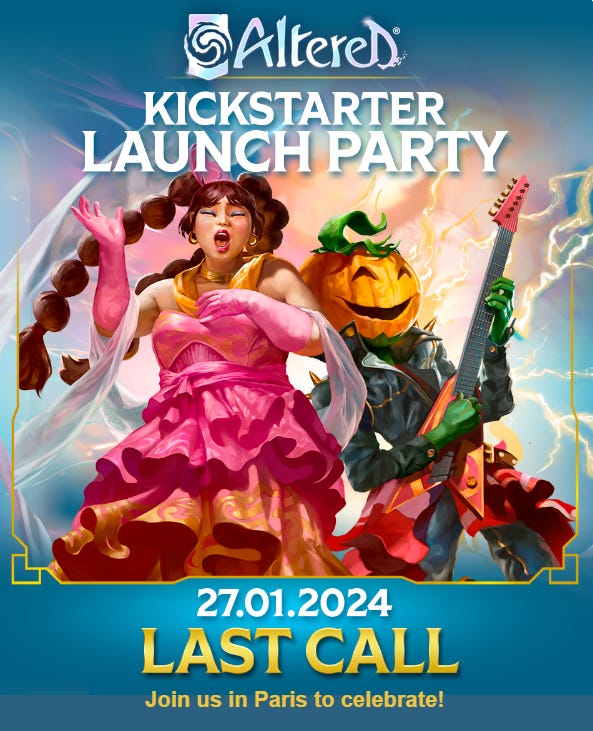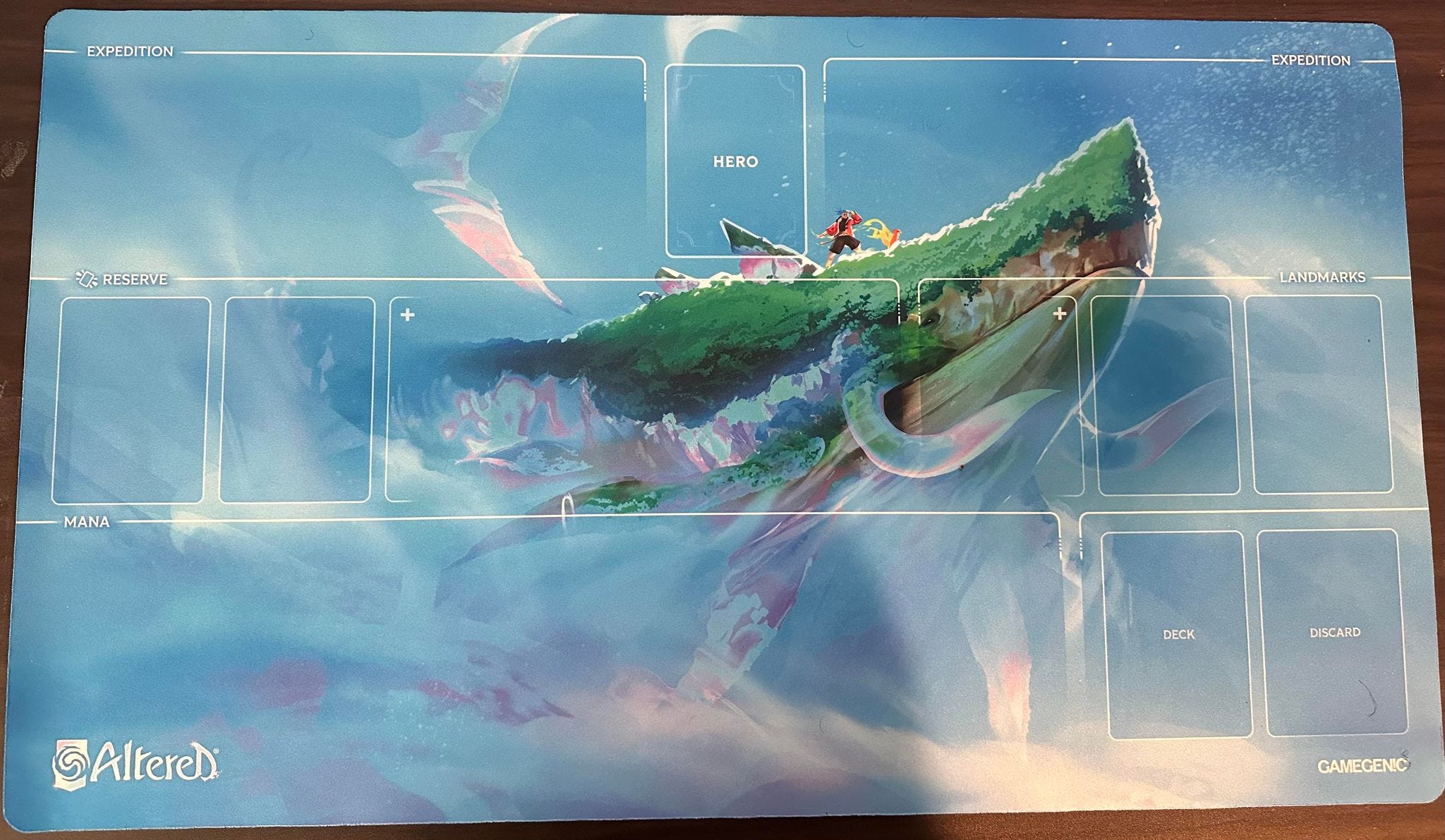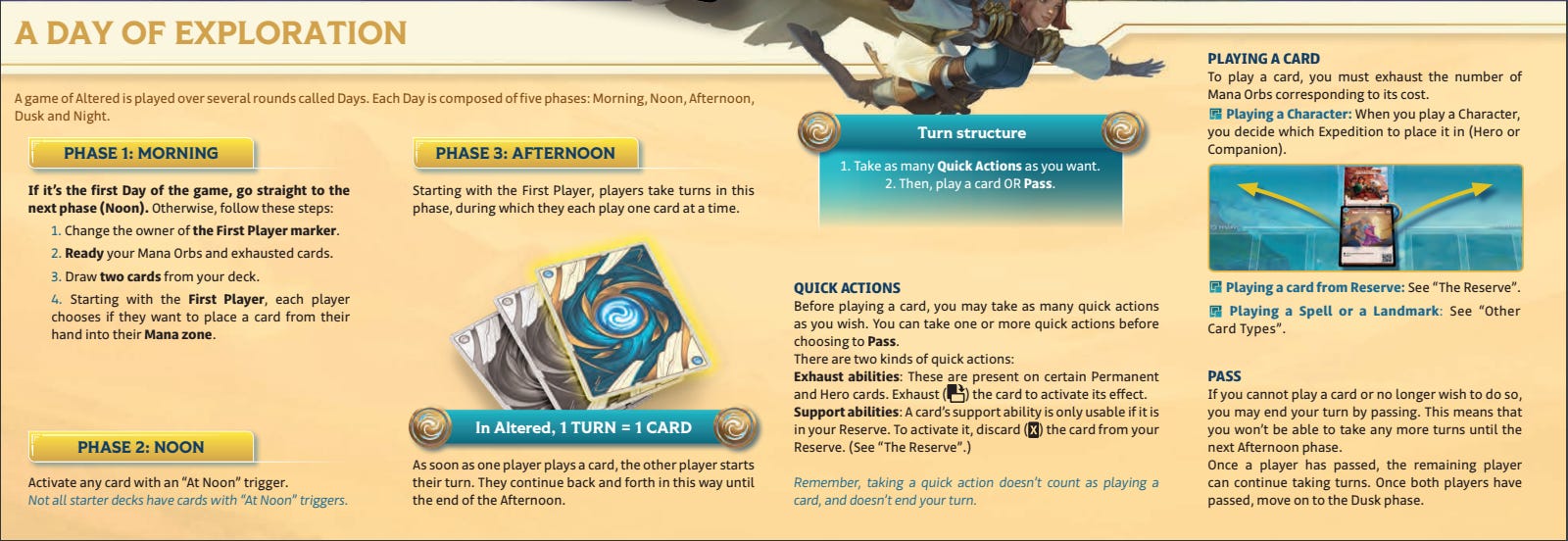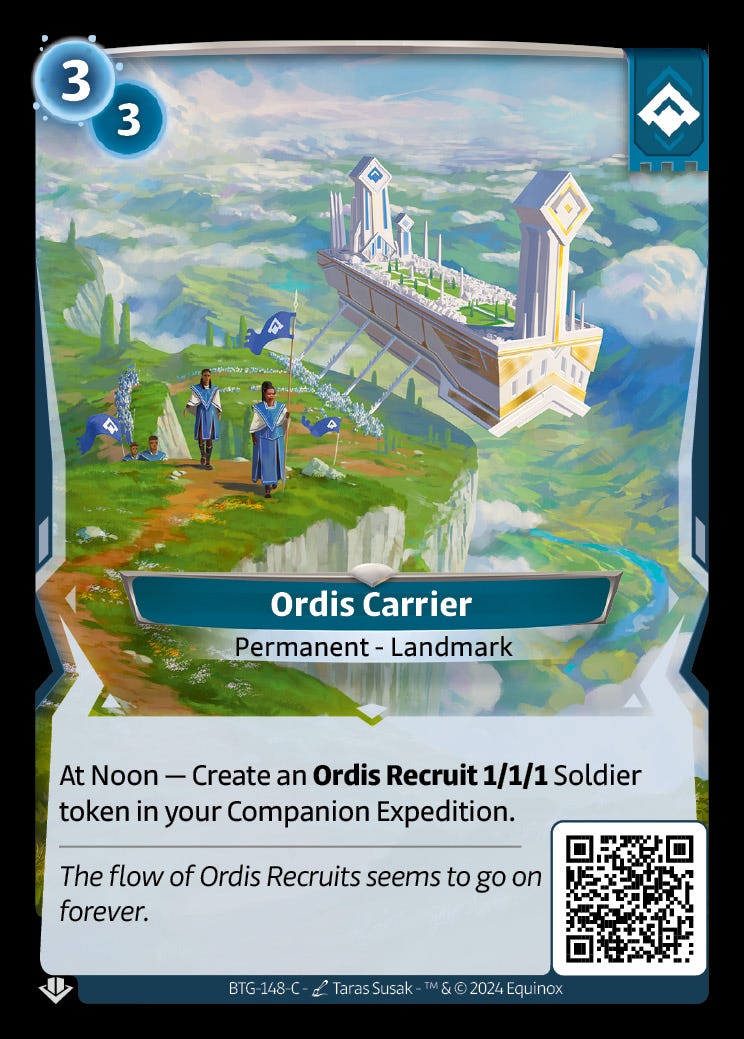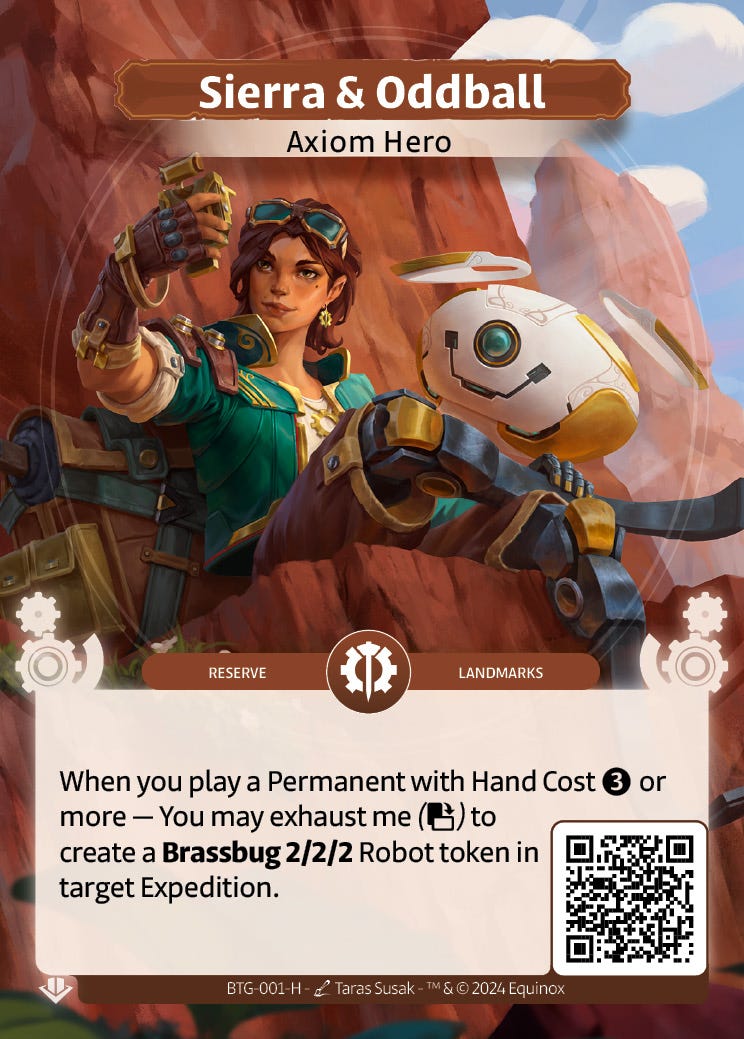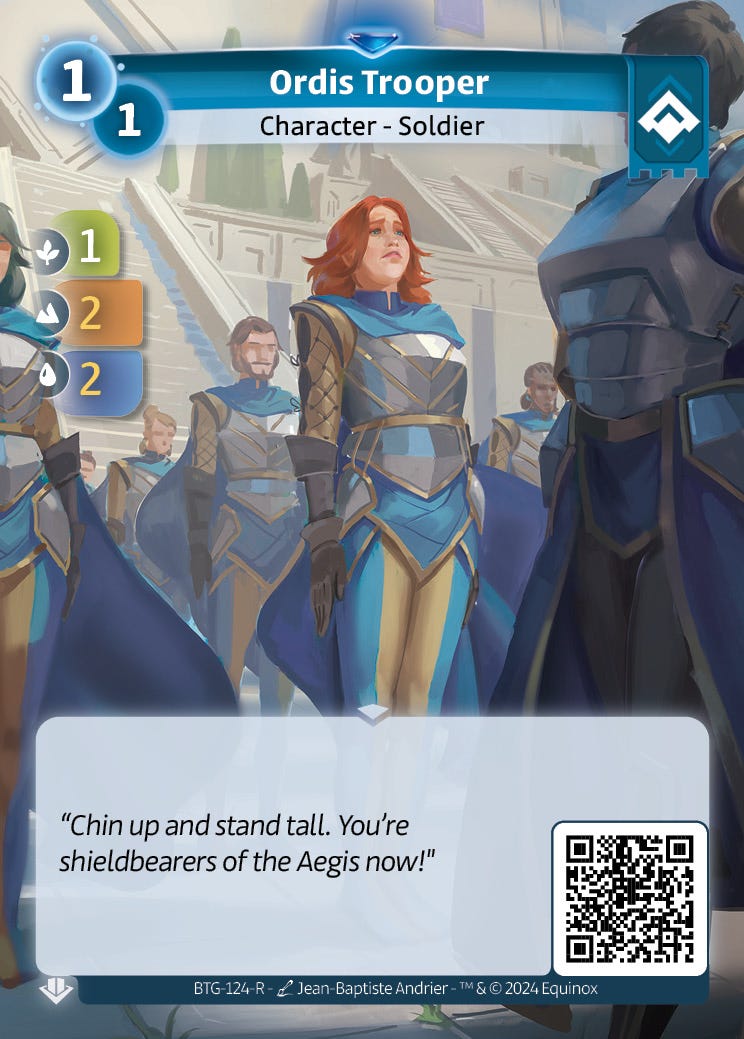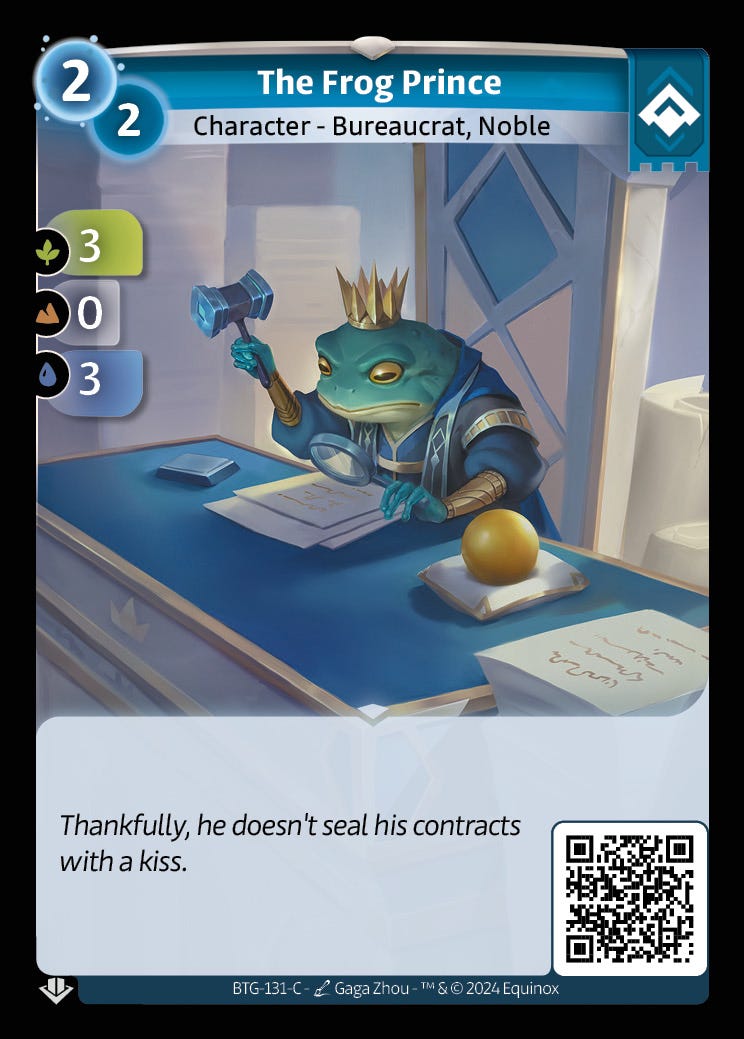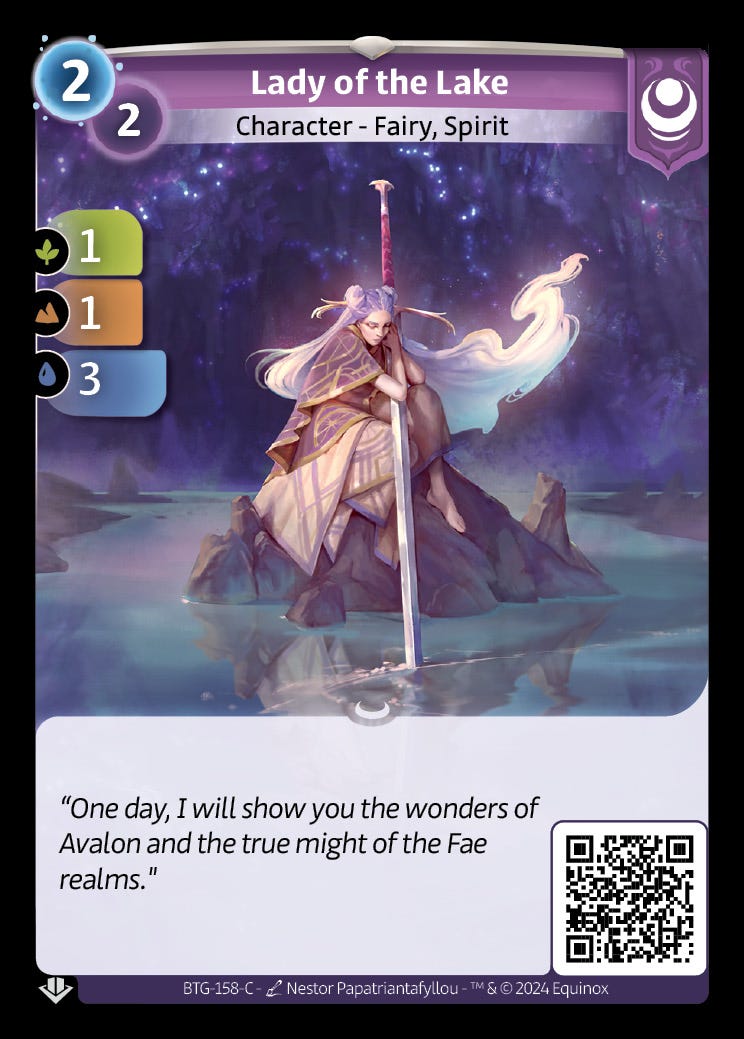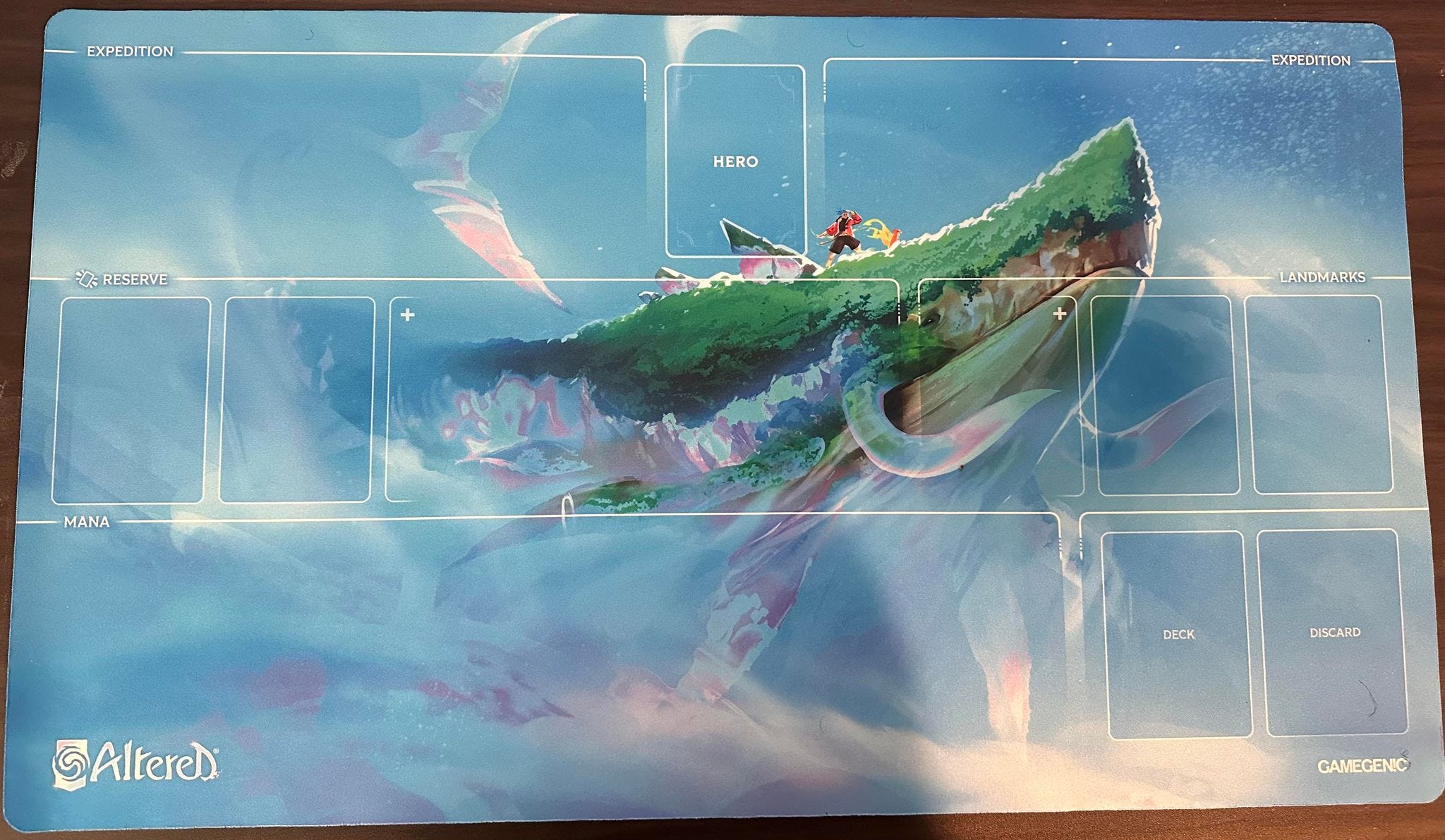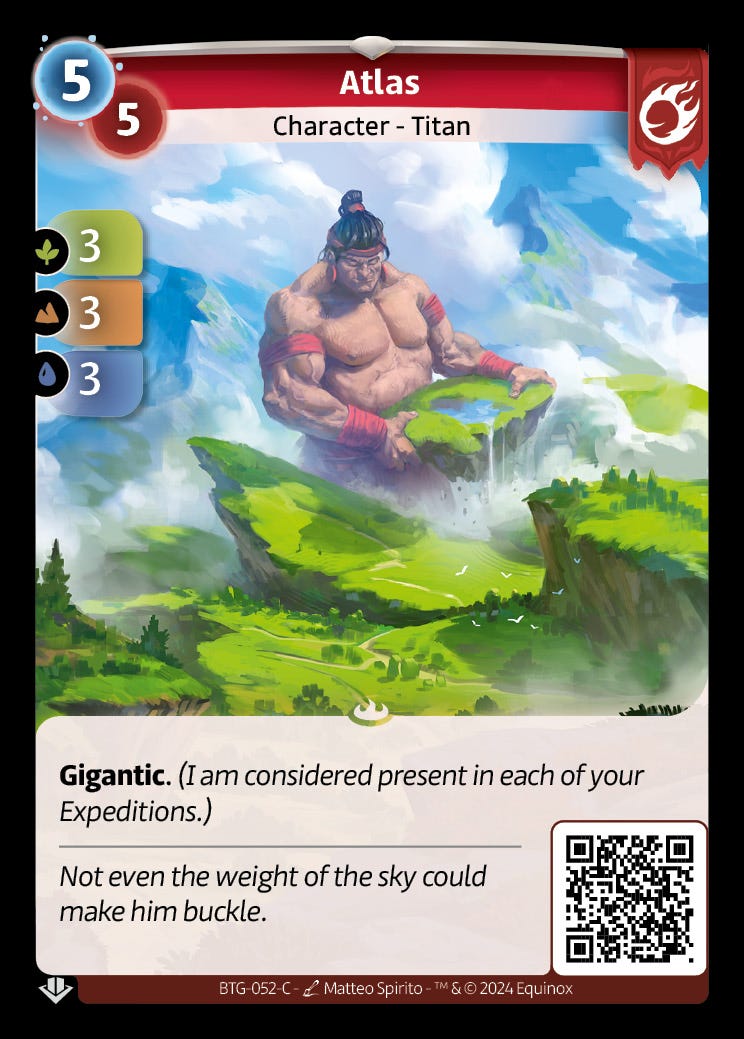Why You Should Give Altered A Try
I don't play a lot of games, but I'm certainly going to be playing this one.
It’s Monday evening and I just got back from Paris. Why in the hell was I was in France for 72 hours, you ask?
Because when your friend and former colleague, Justin Parnell, invites you to go play a new game he’s working on, and the company he works for, Equinox, offers to pay for your travel, you drop what you’re doing and you go. #Blessed
Lemme get the nonsense out of the way first — I’m not being paid to put this blog post together. Quite the opposite in fact. Yes, the fine folks at Equinox were kind enough to get me to their Kickstarter Launch Party, but if you know me in the slightest, you know that if I don’t like something, I’m more than happy to say as much.
The good news? I like Altered. A lot.
So today I’m going to give a brief rundown on my short history with the game, how the game works, and how you can get started if you’re looking for a new game to play.
How My Journey Began
I first heard of Altered in the same way many others have — Justin Parnell’s retweets. I didn’t really know what any of it actually was, but I did find the Twitter graphics aesthetically pleasing —probably because they’re based around my favorite shade of blue — which was already a step in the right direction. More importantly, I had the secondary thought of “If the Twitter graphics are any indication of what the game’s world is going to look like, I’ll likely enjoy looking at the cards while I play.” I’m not a big art guy in any game that I dabble in, but I do know what I like looking at when I play games, and in that regard, I was immediately a fan of what Altered had put together.
Parnell’s retweets were based around deck reveals, road shows, and Mr. Beast giving away $250,000. The deck reveals were daily tweets of the six starter decks Equinox created for the game, the road shows were locations, mostly local game stores, where you could try Altered out (you can find a roadshow near you here), and Mr. Beast gives away a bunch of money all the time, so who cares.
There was just one problem with all these tweets…
The problem that DeusVult had was the same one I was having. I scoured Altered’s website for a rules document numerous times and continuously failed in finding one. Much like the tweets Altered was making, their website was beautiful to look at, but if DeusVult and I couldn’t figure out how to actually play the game, I imagine others were having the same problem.
The good news is that someone finally pointed me in the right direction during my stay in Paris, so if you’re having as much trouble as DeusVult and I had finding an actual webpage to answer your questions, you can find Altered’s Quick Rules here.
You’re welcome to read and review the linked webpage, but explaining how to play a game is fun for me, so I’m going to do just that.
Getting Started
Altered is a two-player trading card game in which each player brings a deck led by a Hero card. Each starter deck is ready to play as-is, but you can customize it or create a new deck from scratch. For ease of education, I’m going to dissect their Quick Rules document and provide my thoughts/opinions to, ideally, make things easier for you as well as provide you with some honest feedback on how the game plays.
In Altered, you lead two Expeditions as they discover and explore the land surrounding your native peninsula of Asgartha. One of your expeditions is led by your Hero, represented by the Hero Expedition marker, and the other one is led by their Companion, represented by the Companion Expedition marker. Your expeditions will progress towards each other as the game goes on, and your goal is to be the first to have them meet up.
To play a game of Altered, you’ll be given quite a few materials. I’m putting an asterisk (*) next to what I believe is necessary to play a game, especially as a beginner:
39 card deck* + 1 Hero card*
This is your deck and its hero. You can’t play the game without either.
6 Token cards
I didn’t receive these at the Kickstarter Launch Party, as cards were pre-package specifically for those attending. I imagine you get these when purchasing a starter deck.
1 Playmat*
Unlike in Magic: The Gathering, where a playmat is a way to show your personality, you need an Altered playmat to play because it designates zones for your cards.
Adventure cards
1 Hero Region card*
Where your Hero begins the game.
1 Companion Region card*
Where your Companion begins the game.
1 set of 3 Tumult cards*
The area that both your Hero and Companion traverse, with the goal of having them meet up to determine the winner.
Markers
6 Expedition markers*
The markers that represent your Hero and your Companion.
1 First Player marker*
The marker that signifies which player takes the first action each turn.
3 Boost markers*
Gameplay markers to indicate which characters have been boosted (a gameplay mechanic).
2 Fleeting markers*
Gameplay markers to indicate which cards have fleeting (a gameplay mechanic).
2 Anchored markers*
Gameplay markers to indicate which characters are anchored (a gameplay mechanic).
1 Asleep marker*
Gameplay marker to indicate which character is asleep (a gameplay mechanic).
2 Rules reminders*
I found these incredibly useful to have on hand when playing the game to have something to consistently refer to in case there’s confusion.
1 Warning card
I didn’t receive these at the Kickstarter Launch Party, as cards were pre-package specifically for those attending. I imagine you get these when purchasing a starter deck.
1 Common foiler
I didn’t receive these at the Kickstarter Launch Party, as cards were pre-package specifically for those attending. I imagine you get these when purchasing a starter deck.
Now that you have all your materials, let’s get everything set up to play!
Take a set of three Tumult cards, shuffle them and place them as shown, face-down in a line between two players.
Place the Hero region card at one end of the line, and the Companion region card at the other end.
Each player places their Hero Expedition marker on the Hero region card, and their Companion Expedition marker on the Companion region card.
Set up the two playmats facing each other on either side of the Tumult.
Each player places their Hero card in the Hero card zone of the playmat.
Randomly determine the starting player (you can flip the First Player marker to do so) and place the First Player marker on their Hero card.
Each player removes all the token cards from their deck, then shuffles the remaining cards and places them face down in the “Deck” zone of the playmat.
Keep the rules reminder cards and the rest of the markers close at hand, and you’re ready to start playing.
Draw 6 cards from your deck, then choose 3 of them to put in your Mana zone, face-down, and ready. The three other cards will form your starting hand.
If you’re familiar with Magic: The Gathering, “ready” is another word for “Untapped”.
Cards in your Mana zone are always face down, and are called Mana Orbs. Each Mana Orb gives you 1 Mana when you exhaust it. Ready all of your Mana Orbs during the Morning phase
If you’re familiar with Magic: The Gathering, “exhaust” is another word for “Tap”.
If you’re familiar with Magic: The Gathering, “the Morning phase” is another name for “the Untap step” (more on that below).
How To Play
Alright! You’re all set up! Now let’s do this thing!
A game of Altered is played over several rounds called Days. Each Day is composed of five phases — Morning, Noon, Afternoon, Dusk, and Night
Phase 1: Morning
If it’s the first Day of the game, go straight to the next phase (Noon). Otherwise, follow these steps:
Change the owner of the First Player marker.
Ready your Mana Orbs and exhausted cards.
Draw two cards from your deck.
Starting with the First Player, each player chooses if they want to play a card from their hand into their Mana zone.
If you’re familiar with Magic: The Gathering, as mentioned previously, think of Morning as the Untap step, but with a few additional bells and whistles. The first thing you’ll do each Morning is move the First Player marker from one player to the other, as it signifies which player takes the first action each Afternoon. Then, you’ll ready your Mana Orbs and exhausted cards. Next, you’ll draw two cards from your deck before, finally, starting with the person who has the First Player marker, each player chooses if they want to play a card from their hand into their Mana zone.
Adding a card from your hand into your Mana zone is how your get access to more mana each turn, ideally to cast your more expensive cards. However, you don’t have to do this if you don’t want to. But, if you don’t add to your Mana zone in the Morning, you can’t do it later in the Day, so choose wisely!
Phase 2: Noon
Activate any card with an “At Noon” trigger.
If you’re familiar with Magic: The Gathering, think of Noon as the beginning of your Upkeep, where the “at the beginning of your upkeep…” trigger(s) takes place.
Phase 3: Afternoon
Starting with the First Player, players take turns in this phase, during which they play one card at a time.
As soon as one player plays a card, the other player starts their turn. They continue back and forth in this way until the end of the Afternoon.
If you’re familiar with Magic: The Gathering, think of this as us both being in Main Phase 1, making our major plays for the turn before going to combat.
Playing A Card
To play a card, you must exhaust the number of Mana Orbs corresponding to its cost.
Playing a Character: When you play a Character, you decide which Expedition to place it in (Hero or Companion).
Playing a card from Reserve: See “The Reserve” (hit CTRL + F for “What’s The Reserve?” to learn more).
Playing a Spell or a Landmark: See “Other Card Types” (hit CTRL + F for “What in the hell is a Landmark?!” to learn more).
In Altered, playing a card during the Afternoon is the same as taking a turn. As soon as one player plays a card, the other player starts their turn. They continue back and forth in this way until the end of the Afternoon.
Quick Actions
Before playing a card, you may take as many quick actions as you wish. You can take one or more quick actions before choosing to Pass.
There are two kinds of quick actions:
Exhaust abilities: These are present on certain Permanent and Hero cards. Exhaust the card to activate its effect.
Support abilities: A card’s support ability is only usable if it is in your Reserve. To activate it, discard the card from your Reserve (again, we’ll get to Reserve in a bit).
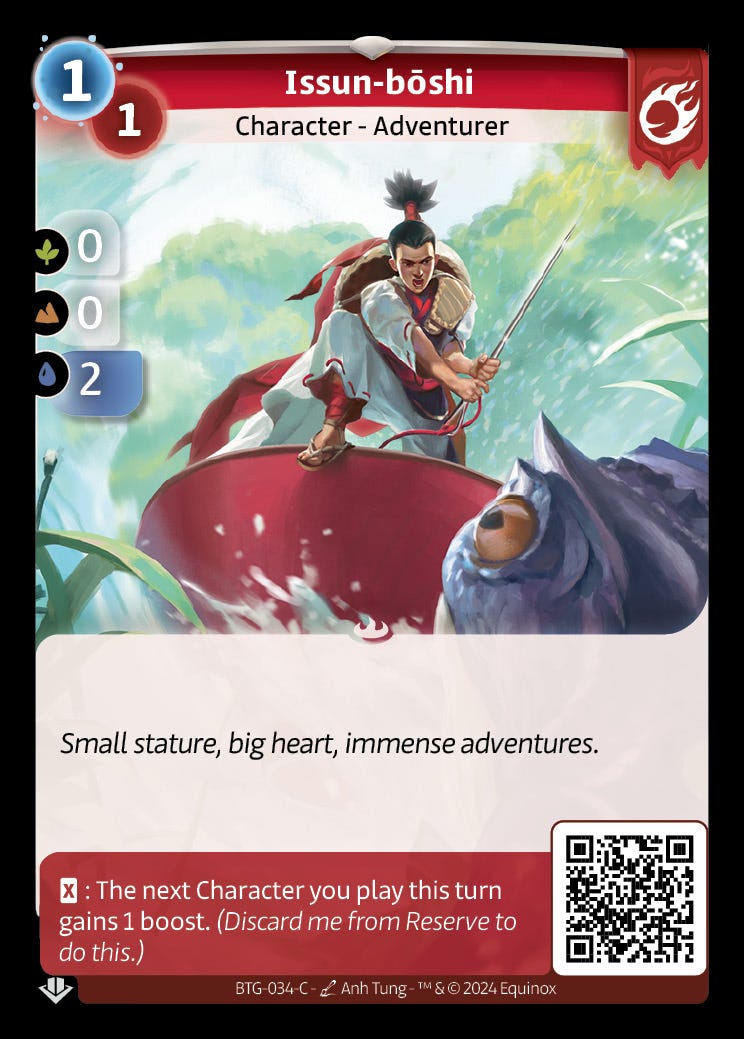
Remember: taking a Quick Action doesn’t count as playing a card and doesn’t end your turn.
The easiest way to think about Quick Actions is that they’re things you can do before playing a card, but don’t count as you playing a card for the turn. I imagine the majority of Altered’s Quick Actions will be beneficial, like the added benefit you see from Sierra & Oddball or the cost reduction you see from Issun-Bōshi, but I think it’s cool to think about the design space that’s available here to Equinox’s game designers.
Pass
If you cannot play a card or no longer wish to do so, you may end your turn by passing. This means that you won’t be able to take any more turns until the next Afternoon phase.
Once a player has passed, the remaining player can continue taking turns. Once both players have passed, move on to the Dusk phase.
The easiest way to think about Pass is that if you’re either unable or unwilling to play a card, your turn is over, which also means your Afternoon is over. The following sequence, for example, cannot occur:
Me: Play a card
You: Pass
Me: Play a card
You: Play a card
I think this is a good thing, because if the alternative was available, we’d be playing this weird guessing game of “Do I wait for my opponent to step into a trap?” that I don’t believe leads to particularly compelling or fun gameplay.
Phase 4: Dusk
During Dusk, players compare the statistics of the Characters in play to determine which Expedition markers can move forward, and which ones cannot.
Starting with one Expedition (Hero or Companion), do the following steps:
Check the region type(s) (🍃, ⛰️, 💧) of the region where your Expedition marker is currently located.
For each of these region types, add up the statistics of the Characters in that Expedition.
If at least one of your totals (for the region type(s) your Expedition is in) is strictly higher than your opponent’s, your Expedition marker moves forward. Otherwise your Expedition stays where it is.
Next, do the same for the remaining Expedition (Hero or Companion).
A few notes:
Your total must be higher than 0 in order to move forward.
Each Expedition can only move forward once per Dusk phase.
When an Expedition would move to a face-down Tumult card, flip it face-up.
You always compare your Hero Expedition with your opponent’s Hero Expedition, even if the two markers are not in the same region. The same goes for the Companion Expeditions.
This is where things start to get a bit confusing, as Dusk is the climax of the Day, where all the stuff you’ve been doing in the Morning, Noon, and Afternoon reaches its resolution. The above graphic by Equinox does a nice job of breaking this down, but here’s an additional run through from my experience with Altered thus far.
Let’s say that I control Ordis Trooper…
And you control Yzmir Stargazer…
We’ve reached Dusk and now it’s time to check the region type(s) (🍃, ⛰️, 💧) of the region where your Expedition marker is currently located. Since we’ve just started a game, let’s check out a Hero region:
You’ll see that I’ve oriented this card horizontally, as this is how it lives during a game. Now to see who moves further on their expedition, we must compare our 🍃, ⛰️, and 💧 totals on each Character we control.
Ordis Trooper and Yzmir Stargazer each have 1 🍃, which means that it’s a tie and neither character wins the 🍃 battle.
Ordis Trooper and Yzmir Stargazer each have 2 ⛰️, which means, again, that it’s a tie and neither character wins the ⛰️ battle.
Ordis Trooper has 2 💧 and Yzmir Stargazer has 1 💧, which means that Ordis Trooper wins the 💧 battle.
So what we have here is tie, tie, and win for Ordis Trooper. According to the rules:
If at least one of your totals (for the region type(s) your Expedition is in) is strictly higher than your opponent’s, your Expedition marker moves forward. Otherwise your Expedition stays where it is.
My Expedition marker moves forward onto the first Tumult card, which was face down…
And now needs to be turned face up!
Since we’re going left —> right in this example, that means I’ve advanced to a Tumult card that cares only about 🍃 and ⛰️. We know that the battle between Ordis Trooper and Yzmir Stargazer is a tie in those two region types. But what if we both add characters to our team during the next Afternoon?
I’ll add The Frog Prince!
While you add Lady of the Lake!
To see who moves further on their expedition, we must compare only our 🍃 and ⛰️ totals because that’s what the region calls for.
My combination of Ordis Trooper (1 🍃 and 2 ⛰️) and The Frog Prince (3 🍃 and 0 ⛰️) means I have a total of 4 🍃 and 2 ⛰️
Your combination of Yzmir Stargazer (1 🍃 and 2 ⛰️ ) and Lady of the Lake (1 🍃 and 1 ⛰️) means you have a total of 2 🍃 and 3 ⛰️
So what happens? Again, we refer to the rules!
If at least one of your totals (for the region type(s) your Expedition is in) is strictly higher than your opponent’s, your Expedition marker moves forward. Otherwise your Expedition stays where it is.
Well, I have more 🍃 (4 > 2), but you have more ⛰️ (2 < 3), so we both get to move forward because we each won one of the region battles.
Onto the next region! But this time, it only cares about 💧!
And that’s the gist of it!
What’s interesting to me about the Dusk portion of Altered is that as you continue your expedition, because the Tumult cards are face down until you get to them, which then forces them to be turned face up, you don’t know what resources you need to care about.
But also, this resolution that’s happening during Dusk is happening twice! It happens on the Hero side (I like to think of it as the left side), but it also happens on the Companion side (I like to think of it as the right side)!
Why is that cool? Because it means there are more decisions to make! Remember this playmat image?
Consider the following:
Do you want to recruit your Characters on the top left Expedition (I like to call this the Hero side) or the top right Expedition (I like to call this the Companion side)? If my opponent played first and has a Lady of the Lake (1 🍃, 1 ⛰️, and 3 💧) on the Hero side, should I recruit my Frog Prince (3 🍃, 0 ⛰️, and 3 💧) on the Hero side or the Companion side? I’ll lose the ⛰️battle, but maybe winning the 🍃 battle matters a ton.
I guess it depends on what the face up Tumult card cares about, right? Or maybe I’m really far behind on the Hero side, but can catch up on the Companion side because my opponent’s Character(s) just don’t have any 🍃 or 💧? That’s some serious thinking we have to do!
And could you imagine if you played a Character on the Hero side, but it also counted on the Companion side? That would be a super sweet design!
Phase 5: Night
Rest: Send all Characters in your Expeditions to your Reserve. If they’re Fleeting, discard them instead.
Cleanup: If you have 3 or more cards in your Reserve, you must discard the excess so that only 2 cards remain. Do the same for your Landmarks.
It’s finally time to answer the question “What’s The Reserve?”
The Reserve is a face-up zone which acts similarly to a second hand of cards. Cards in Reserve can be played as if they were in your hand. However, when you play a card from Reserve, pay its Reserve Cost instead of its Hand Cost. A card played from Reserve gains Fleeting (unless it’s a Landmark).
Wait! What in the hell is Fleeting? And what in the hell is a Landmark?!
Fleeting means “If a Fleeting card would be sent to Reserve, discard it instead”. For Characters, place a Fleeting marker on the Character to remind you to discard it the next time it would go to Reserve.
Think of Fleeting as “You get to use this card once, so you better make it count.” That’s my shortcut for it and I think it (mostly) works. I’m a big fan of single use cards so Fleeting it very welcome.
As far as Landmark is concerned?
A Landmark is a permanent that you put directly in your Landmark zone. Not all starter decks have Landmarks in them.
Think of Landmark as a permanent that’s pretty tough to interact with. For you Magic: The Gathering players out there, I think the best comparison is an enchantment or artifact, insofar as if you want to interact with those, you’re doing so with intention.
Ok, back to The Reserve! Equinox made this useful graphic to breakdown every aspect of a card, including, most importantly, its Reserve Cost:
Think of The Reserve as the second use of a card, or, if you’re familiar with Magic: The Gathering, Flashback. Sometimes a card’s Reserve cost will be more than a card’s Hand Cost. Sometimes it’ll be less. It just depends on the card, which, of course, will change how you play with it.
The Reserve is cool for a few different reasons:
The aforementioned potential difference in Hand Cost and Reserve Cost on cards (not just Characters!) means that gameplay should be dynamic because the same card can have different costs.
Remember — if you have 3 or more cards in your Reserve, you have to discard the excess so that only 2 cards remain. That should make for some fun decisions over the course of a game.
A card can only use its Support Ability if it’s in The Reserve, which means deciding what to keep in that zone won’t be easy.
How To Get Started?
There’s a few different ways to do so:
Find an Altered Road Show near you. This will give your the opportunity to learn how to play alongside someone who knows how to both play and explain the game to you.
Print & Play yourself. No, this is not a joke. Equinox is encouraging people that are interested in learning Altered to print the cards themself to start your own journey.
Join Board Game Arena. Until February 5th, Altered is playable on Board Game Arena if that’s your thing.
Join the Kickstarter. With over 11,000 followers awaiting the Kickstarter’s launch this week, you certainly don’t want to miss out on what the Kickstarter has to offer.
Find me at RC Denver. Regional Championship Denver is February 9-11 and I’ll have the six starter decks with me to do battle with. Come find me in between rounds and I’ll be happy to play a game or two.
I said it on Twitter over the weekend and I’ll reiterate it here — I don’t play a ton of non-Magic games. I’ve dabbled in a few other TCGs here and there, and play the occasional video game on my Nintendo Switch, but by and large, I’m a Magic player and have been for 25+ years.
But just because I love Magic doesn’t mean other great games can’t exist. And while I’ve probably missed some other great games over the years, I can only tell you how I felt while playing Altered over the weekend — pure joy. It felt fun. It felt refreshing. And, most importantly, it felt different.
Give Altered a try. I think you’ll be glad you did. 🙂





